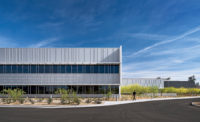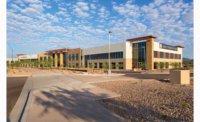The more than 2-million-sq-ft, five-building Marina Heights complex in Tempe, Ariz., was erected safely despite a fast-track schedule. Built alongside Tempe Town Lake on a 20-acre parcel, project officials say the development is the largest office project ever built in the state.
Crews have compiled 3.5 million work hours without a lost-time accident since the project began in July 2013, which the construction team attributes to proper planning and a detail-oriented safety culture.
“Constant attention to safety was paramount for us,” says Rich Montague, division manager with general contractor Ryan Cos.
Several areas of the $600-million complex have already been turned over to end-user State Farm—beginning in 2015—and final completion is expected in summer 2017.
Currently, four of the five buildings are occupied. The heights of the buildings vary from six to 17 stories. Building D and the below-grade garage were the first structures the team completed in October 2015. Building B was finished in May, and Buildings C and A were completed in July. The final retail structure will begin construction this month. The final office structure awaiting completion is Building E, which has an expected completion date in February. Ryan Cos. also expects to finish the nearly complete plaza in the same month.
Safety First And Last
The project reached its safety milestone despite dealing with a relatively crowded worksite and a complicated four-year construction schedule that operated 24 hours a day. In the middle of the construction period, Marina Heights had roughly 1,200 workers on site during day shifts, and the site was nearly as crowded at night because the high temperatures in Arizona often required workers to pour concrete after the sun went down.
“We poured concrete every day for the first two years, and some of the nights that we poured concrete we had over 700 trucks deliver to the site all night long,” says John Strittmatter, Ryan Cos. chairman for the Southwest region.
Additionally, by project completion, 200 subcontractors will have contributed to the development and construction of Marina Heights. Of those subcontractors, only four will work on the entire project, Walters & Wolf, Otis, Kovach and Suntec Concrete, says Strittmatter.
Planning For Safety
Ryan Cos. made safety a priority from the beginning by establishing a team of safety superintendents that included Kyle Schoenberger and Nick Laughlin. At least one safety superintendent is on site 24 hours a day to ensure workers, subcontractors and others are following Ryan’s safety protocols, including weekly foreman meetings and monthly safety shutdowns.
The more than 6,000 workers and subcontractors on the project have gone through Ryan’s safety training program. Ryan also required subcontractors with more than 25 people working on site to have their own dedicated safety person. Subcontractors with more than 100 workers on site needed two dedicated safety personnel.
The company also took potentially dangerous situations seriously, holding meetings with subcontractors following any incidents, such as a fallen piece of plywood, even when no accident occurred.
“We have safety meetings before [subcontractors] get on site, while [subcontractors are] on site, and we do a summary after the [subcontractor] is complete with their particular part of the work,” says Strittmatter. “It is a full-time, 24/7 safety operation that we monitor, educate and assess during the entire four-year project.”
Technology also played a role in Marina Heights’ exceptional safety record as the company “constructed the project twice,” according to Strittmatter. Ryan Cos.’ virtual design and construction team utilized building information modeling to virtually build the campus. This allowed subcontractors to fabricate building components off site in environmentally controlled conditions, which resulted in a less congested worksite and contributed to overall efficiencies.
The subcontractors could then bring the completed pieces to the jobsite and connect them like Legos.
Jerry Barnier, founder of project subcontractor Suntec, says safety superintendent Schoenberger was a driving force for the safety plan.
“There was really good time spent solving safety issues before the work even started—a lot of really good analysis as we moved into every area. We learned a lot from the whole experience, and I think everybody did,” Barnier says.
Ryan Cos. also engaged the Tempe Police and Fire departments and invited them to the Marina Heights worksite on several occasions so emergency personnel could become familiar with the site and go through training processes in the event that an accident did occur, says Montague.
Ryan Cos. received the Safety and Health Achievement Recognition Program accreditation from the Arizona Division of Occupational Safety and Health for the project in November 2015.
In addition to worker safety, 3D modeling contributed to time and cost savings and also helped the project stay on schedule. Marina Heights opened in phases rather than a standard handover. While the end-user for the project officially remained a mystery when the project broke ground in 2013, State Farm eventually confirmed that the complex would be the site of its newest regional hub. Ryan Cos. and DAVIS comprised the design-build team and collaborated with developer Sunbelt Holdings to deliver the buildings on schedule according to State Farm’s needs.
State Farm plans to have up to 8,000 employees at Marina Heights after project completion.
“Because we had the two levels of below-grade parking beneath the entire campus that ties everything together and the plaza level which really ties everything together, the team wanted to work the site from the center outward,” says Richard Drinkwater, DAVIS principal architect and project designer. “So the three center buildings opened in sequence first along with the parking beneath, and then the two end-flanking buildings will complete the build-out.”
The project team also took special pains to be “good neighbors” to the surrounding Tempe community as it constructed the large office complex, says Strittmatter. That meant making sure the cement trucks and other equipment were not putting an undue burden on traffic moving to the congested Mill Avenue district and surrounding communities during the morning rush hour.
Ryan accomplished this by coordinating with Tempe’s streets and traffic operations department, Arizona State University and local homeowners associations before and during construction, says Montague.
Lakeside, Upside Issues
Besides managing more than 1,000 daily workers and end-user operations before the end of the project, the construction team faced several other complications. The project has two levels of below-grade parking that sit beneath the complex. The lower parking level is below the water table, so the project team constructed it as a “bathtub” to eliminate flooding issues. The garage has 3,368 parking spots and 1.36 million sq ft of construction area.
Ryan Cos. hired a variety of consultants to help determine the best solutions for the below-grade structure, including geotechnical engineers, waterproofing consultants, hydrology consultants and suppliers, says Montague. The project team selected a combination of drainage mats in addition to membrane material from W.M. Grace. The drainage mats wick water away from the vertical or horizontal surfaces, with the membrane material providing a secondary barrier if there is a buildup of water resulting from an increase in the water table.
“We [studied] injection wells and pumping systems, but, due to a variety of technical issues, we elected to utilize the membrane barrier solution to [protect] the garage from water intrusion,” says Montague.
The project team came up with a variety of solutions to deal with fluctuating water tables and potential 100-year flood events. They ran buoyancy calculations to ensure the foundations would not float in high water table conditions, and the potential for 100-year flood events influenced the shoring designs and finish-floor elevations of the plaza.
The team went with a mat-slab foundation system for a majority of the project that varied in thickness from 2 in. to 9 in. In a limited area of the site, they chose to go with caissons due to soil conditions. The rest of the site uses mat slabs, due to the need for speed and issues with drilling caissons in high water tables. Pump systems are also in place, primarily to remove stormwater from a normal rainfall event. They will capture all rainwater for the campus into a series of six vaults and pump it out into the city storm drain system.
“The challenge we had when designing the project was how to handle fluctuating water tables, the potential of 100-year flood events and maintaining an accessible below-grade garage for all employees,” says Montague. “The solution was a variety of waterproofing solutions. This is a common design and construction challenge experienced in other markets, but not often required in the Phoenix market.”
Marina Heights also required an extremely large amount of construction materials. And the combination of a long-term lease and a high-profile occupant called for higher quality finishes to provide what Montague calls a “top flight campus” that acts as a “real showpiece.”
The glass exterior of the building was created using a unitized glazing system. Because the buildings are in the flight path from Sky Harbor International Airport, the buildings were designed for 1-1/16-in. glass rather than standard 1-in. glass, providing a higher STC rating and flatter appearance. Subcontractor Walters & Wolf used 10,050 units of unitized panels, 630,000 sq ft of exterior curtain wall and 100 tons of stainless steel cladding and trim on Marina Heights.
The overall look of the facility resulted from a desire to create a modern-looking complex that fit State Farm’s needs for large floor plates, necessitating large, bulky buildings.
“Clearly, [the buildings] should not be masonry or concrete or bunker like,” says Drinkwater. [The client] really wanted to have a 21st-century engineered high-tech aesthetic. The choice of the glass curtain wall was [made by DAVIS]. Obviously, it’s very high performance glass, but also there’s an artistic aesthetic in the way it makes those buildings at times disappear or read very metallic.”
Suntec Concrete utilized four separate batch plants throughout the metro region to supply 299,115 cu yd of concrete. In preparing the site, Buesing excavated and hauled 450,000 cu yd of soil.
The buildings themselves account for more than 3.5 million sq ft of construction area and range in size from 259,250 rentable sq ft to 584,507 rentable sq ft. Beyond the office space, Marina Heights will feature two retail buildings totaling 14,350 rentable sq ft, a 5.9-acre plaza and above-ground parking that brings the total number of spots to 8,124.
Local utility Arizona Public Service installed dedicated power to the complex in a redundant system requested by State Farm to avoid the company’s operations going off line.
Additionally, Marina Heights utilizes an energy efficient HVAC system.







Post a comment to this article
Report Abusive Comment